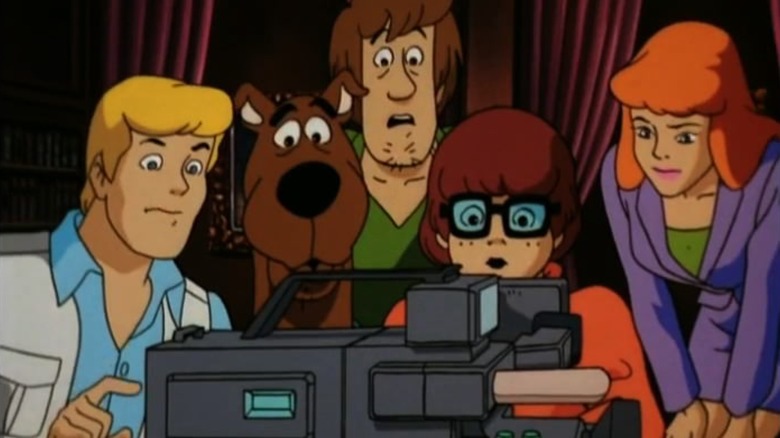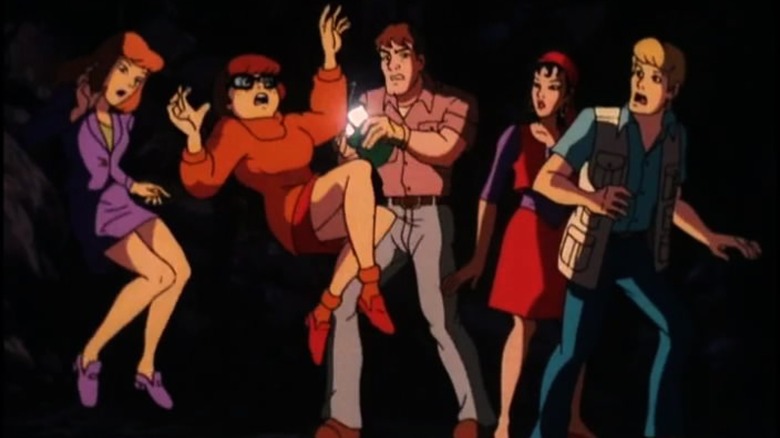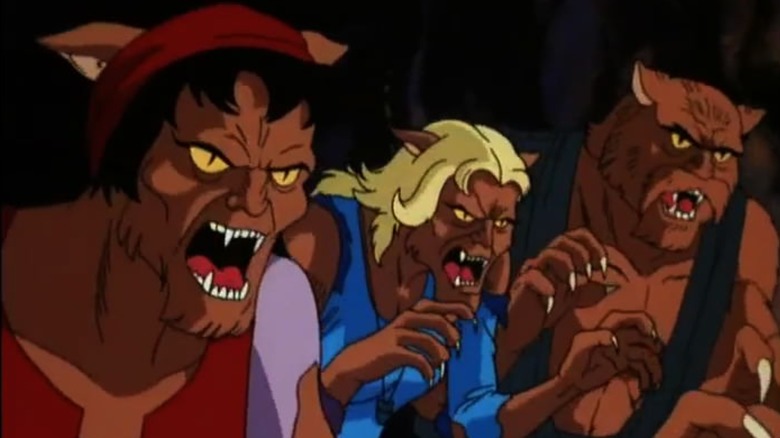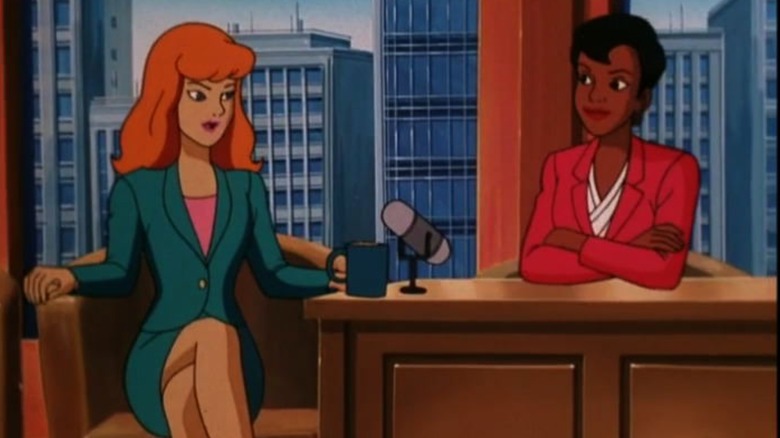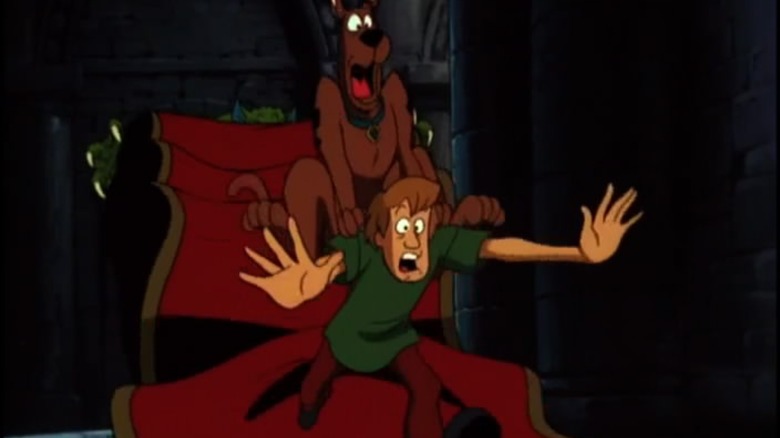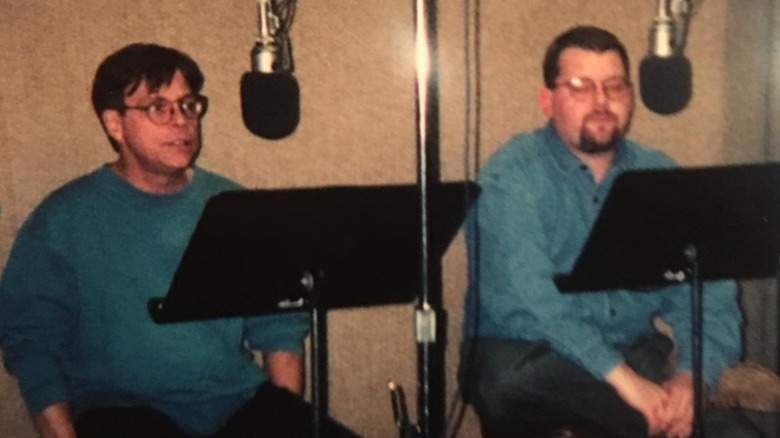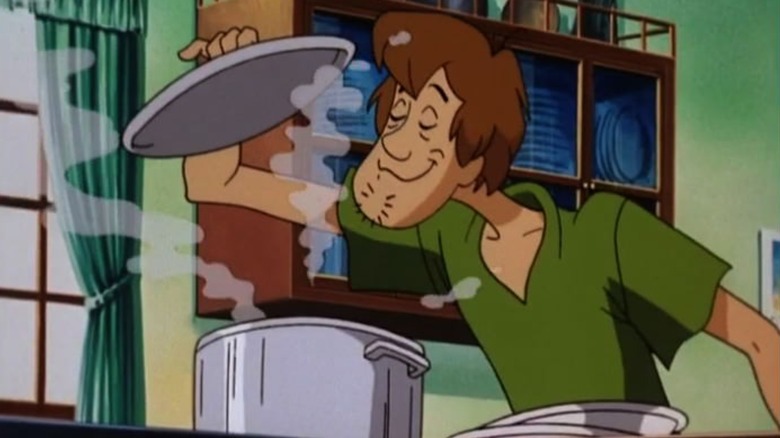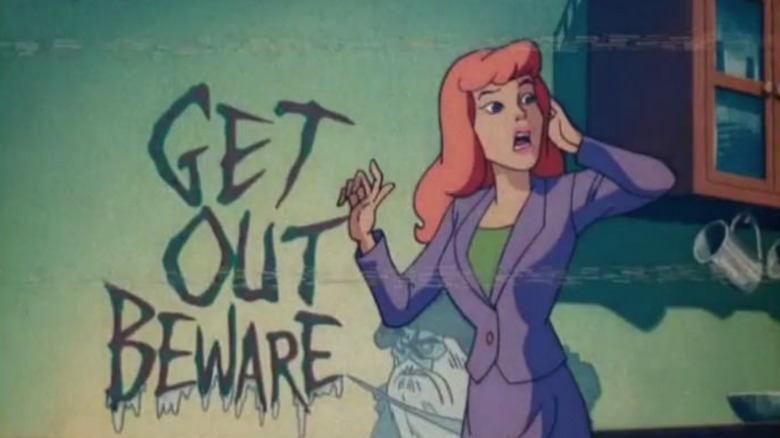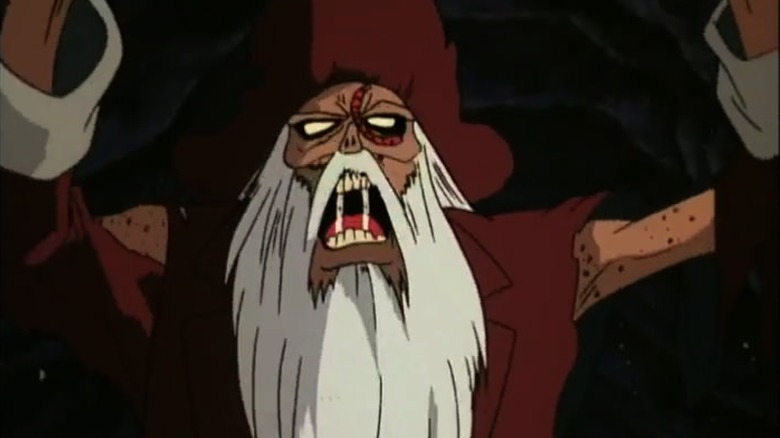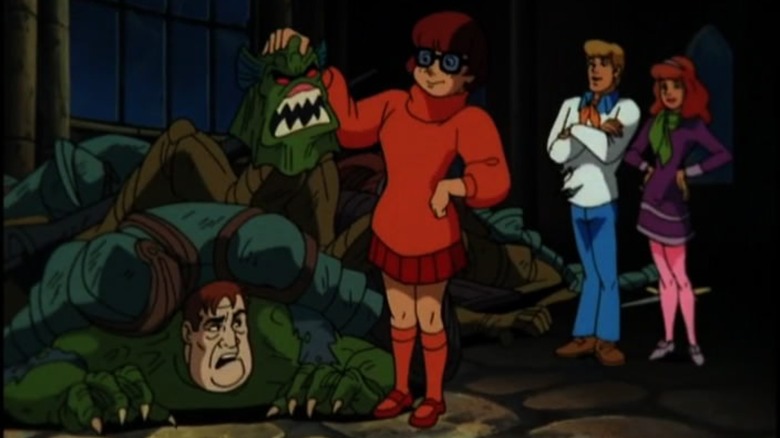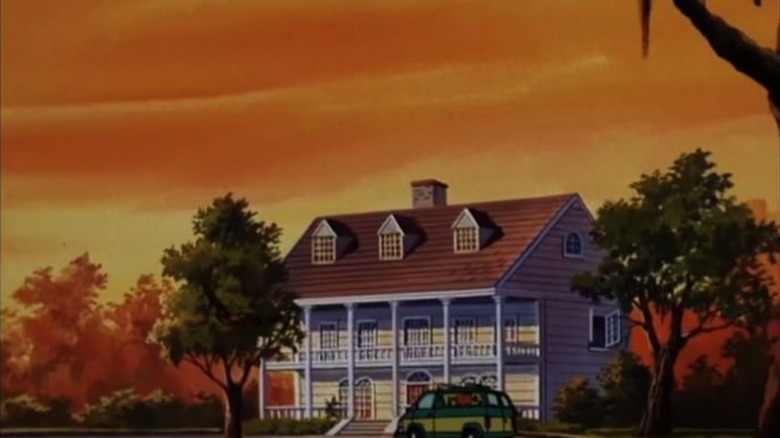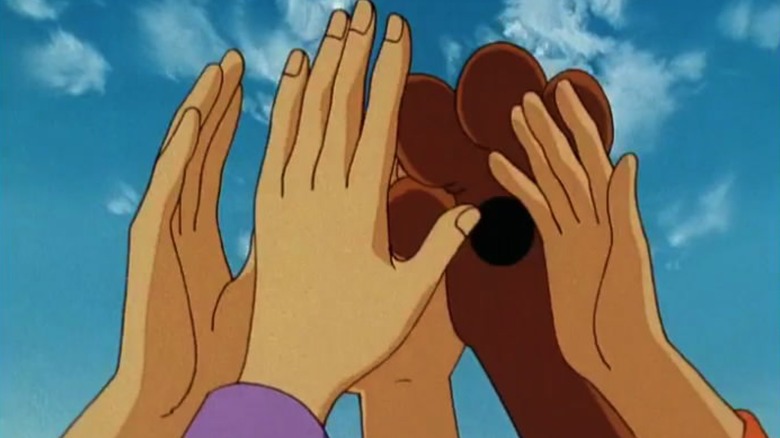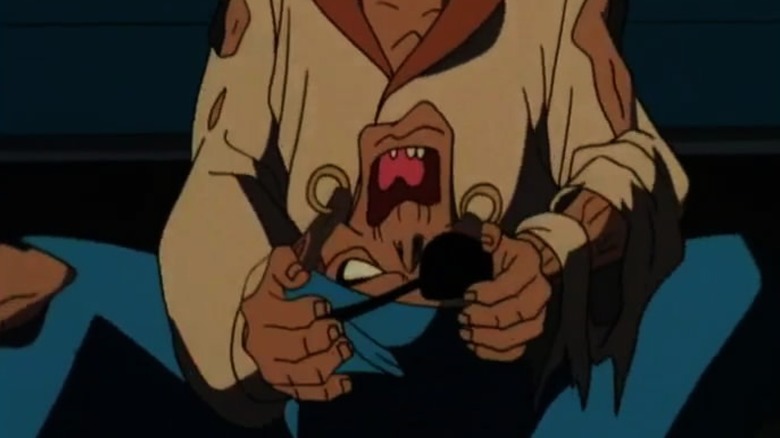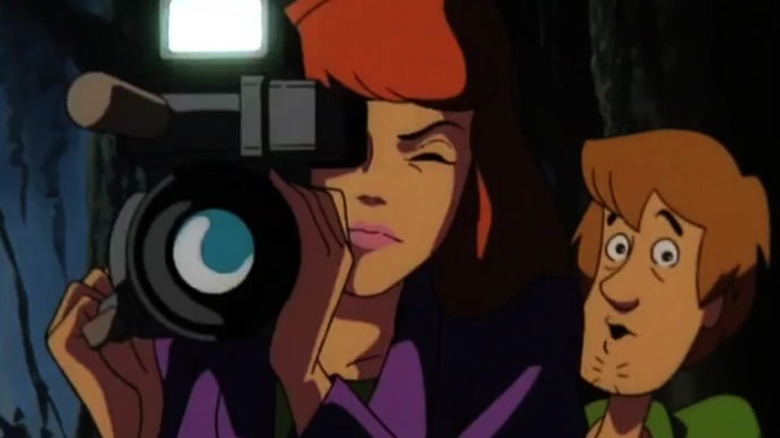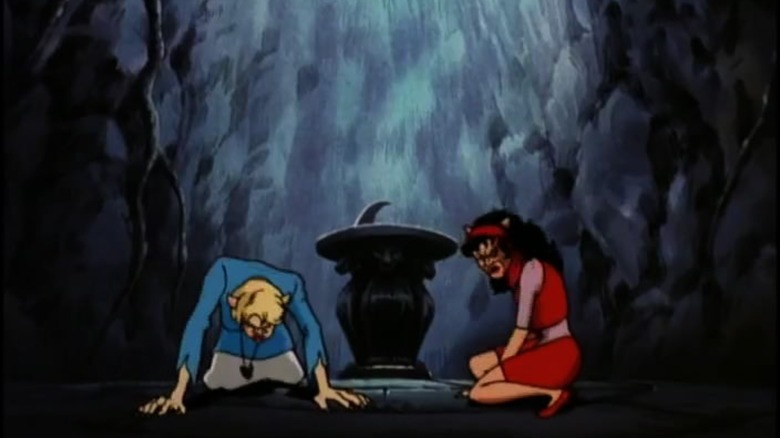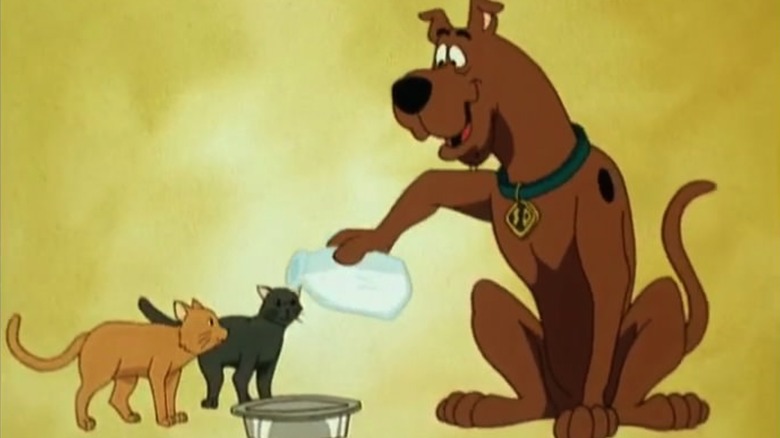'That Was The End Of An Era': The Oral History Of Scooby-Doo On Zombie Island
If you came of age sometime between 1969 and now, there's a good chance you grew up with Scooby-Doo. The snack-loving Great Dane became a mainstay in homes across America when "Scooby-Doo, Where Are You!" first premiered, and Mystery Inc.'s reputation kept growing long after Joe Ruby and Ken Spears' groovy series ended its three-season run. In the decades since, Scooby, Shaggy, Fred, Daphne, and Velma have become a global phenomenon, and even during low points in Scooby history (like 2022, when the apparently nearly completed film "Scoob 2" was canceled by Warner Bros.), there's still a strong sense of cultural awareness for the lovable pup and his mystery-solving crew.
Scooby fans are also well-known for our strong opinions; with over a hundred Scooby titles to choose from across film, TV, web, comics, and more, Scooby fans have a knack for developing a strong individual sense of what works and what doesn't in the franchise. While most fans may not agree on what Scooby properties constitute the worst the series has to offer, a surprisingly high amount agree about which Scooby movies are best: The four-film late-'90s run that signified the start of Scooby-Doo's direct-to-video series, beginning with "Scooby-Doo on Zombie Island."
Released 25 years ago on September 22, 1998, "Scooby-Doo on Zombie Island" ushered in a new era of Scooby. The movie was scary and funny. It was punctuated by catchy music and beautiful creature design, with real monsters and a surprisingly adult plot about wronged women seeking vengeance. It also had zombies, pirates, voodoo dolls, and werecats. "Zombie Island" might have felt like a trendsetter, but as subsequent Scooby films slowly began to fall into a more predictable formula, it proved to be one-of-a-kind.
Many people involved in the making of "Scooby-Doo on Zombie Island" are retired or don't give interviews, and a few have sadly passed away. But in honor of its anniversary, four people involved in the film — plus the writer behind its polarizing sequel — spoke with /Film about the making of the film and its legacy today.
Note: These interviews have been lightly edited for clarity and brevity.
'Why don't you guys make a Scooby direct-to-video?'
In the mid-'90s, Scooby-Doo was experiencing growing pains. After "A Pup Named Scooby-Doo" ended in 1991 and the franchise's first run of animated TV movies puttered out with 1994's "Scooby-Doo! In Arabian Nights," it would be four years until another Scooby story graced fans' screens — the longest release gap since the show's 1969 inception. Behind the scenes, though, historic animation studio Hanna-Barbera had recently been bought by Turner Broadcasting System, which then merged with Time Warner. Amid a period of major upheaval, the powers-that-be started thinking about bringing Mystery Inc. someplace they'd never been before: Direct-to-video.
Lance Falk, model coordinator: The movies [were] always the best experience in Scooby because of the team. It was [story writer and supervising producer] Davis Doi, my favorite boss I've ever worked for. [Director] Jim Stenstrum, one of the best designers I've ever worked with but also an old friend who got me into the business, recruited me out of the accounting department in Hanna-Barbara, so I owe him everything. And I owe Davis everything. And then we have Larry Houston, who's a great producer. I love working with him. And Glenn Leopold, who's a terrific writer. And we made kind of a brain trust, kind of a team...
We had a little mini development team, and we were working on a lot of HB or Warner-owned properties. I wrote a "Road Warrior" treatment because that was something Warner Brothers owned, which I think would've been really — well, everyone thinks their thing would've been really good, but we were just kind of doing that, not getting any traction. And it turns out we were like a team no one knew what to do with, but they wanted to do something with us.
Scott Innes, voice of Scooby-Doo: When they made this, originally this was going to go to motion picture, it was going to go to the movies. And then something happened, and it ended up just going direct to video.
Falk: This might be anecdotal or apocryphal, but there were some polls taken in supermarkets, like with moms and things at Costco and Target: "Here's a list of characters, which characters do you know?" Scooby always blew off the top of those lists, beyond Jetsons, Flintstones, Jonny Quest, things I guess you like more personally, but Scooby was always big or really strong in that.
Warner Brothers wanted to enter the direct-to-video, feature-length market, which was just kind of starting up. And Warner Brothers had done some real successful things with Batman and so forth. So they said, "Why don't you guys make a Scooby direct-to-video? See how that goes" [...] Historically, there had never really been a long-form. There had been specials that were an hour long and things, but a feature-length Scooby story had never been done before. So that was just kind of dumped on the team. Glenn was, "Woo!" super thrilled because he freaking loves Scooby. And the other three of us were like, "Yeah, it's all right." It's one of a lot of things we could have done.
'This time, the monsters are real'
Previous incarnations of Scooby-Doo had largely focused on solvable mysteries with human culprits, and were known for ending with unmasking scenes that explained the villain's motivations and saw them arrested. The few titles that strayed from this formula, including "The 13 Ghosts of Scooby-Doo" and films like "Scooby-Doo and The Reluctant Werewolf," portrayed monsters as goofballs, not villains. But the development team decided the new movie would change that, a choice that would go on to inspire its memorable tagline: "This time, the monsters are real."
Falk: Glenn, Davis, myself, and Jim were in a room, and we just started, like, "Okay, we're going to make a Scooby movie." Jim spoke up first. He's an artist, and he loves monsters and so forth. He's even written novels about monsters. So he said, "Can we just get rid of the taking off the mask thing? It's old. It's tired. Can we? Yeah, because I want to do real monsters. They physically can be real monsters." And Glenn Leopold, who's like the defender of Scooby-Doo, said, "Well, wait a minute. The fans want to see that because that's what Scooby-Doo has always been." And Davis said, "This is true, but you can yank people's chains for about a half an hour, but you can't do it for an hour and a half and have it be a fake. It feels like the end where somebody wakes up, and it's a dream. It just feels like a cheat."
It's like, I was talking about "Twilight Zone." The original "Twilight Zone" is the only real half-hour version, and that's the only version that really works, because the stories are structured like jokes. When you get to that punchline, you don't want to have an hour to think about what the punchline means. You want to just be engaged in the story, and when it hits you, it hits you. Some people will get there first, but mainly you won't. But when they started doing hour "Twilight Zones," which they even did in the original run, they're dragged out.
So I felt Davis's point for Scooby was a really good point. What you can get away with in 20 minutes, you cannot in 90. I was the guy that said — and this is, I'm only bragging about this because this is my one big, big contribution for the whole thing — I said, "We've got to do both. We have to have an unmasking for the fans, but we have so much room. Let's also have real monsters and mix the story and make it a thicker broth." That way, you can actually do things, like you think something is about one part of the story, but it's really about the other. If you play fair with the audience, you don't give them false clues, but you do kind of lead them down false assumptions. That way, we have our cake and eat it too. We can make the fans happy. We can make ourselves happy. We can make a better story.
Innes: The monsters! Of course, it was the first time that the monsters were real. So they were going out on a limb on this thing, and it could have backfired big time.
Falk: Both Glenn and Jim are gigantic monster movie fans, and so they're going to have those conversations and, "Oh, you know what'd be fun? You know what'd be fun? You know what'd be fun?" I mean, the werewolf thing was actually kind of, the werewolf aspect was a plot kind of culled from an unused "Jonny Quest" script that Glenn had done, because why not? It never even got used. So, he took that. The "Jonny Quest" script was called "The Curse of Kataluna," I think, something, and he intelligently reappropriated that.
And then, zombies are just fun. Jim loves drawing zombies. And he said, "Oh, I can do pirates, I can do Civil War guys, I can do..." And so, I think really, it's those two guys. Davis and I are a little more sci-fi influenced, and I did a space one, Glenn and Jim are deeply in monster territory.
Innes: You still had a few people [watching] that were like, "Hey, you got away from the formula." But you had enough people to go, "Wow, we're in a different time now, and that's weird because that was cool to see them kick the real monster's butts and bring them all out and unsolve that mystery." All the way from "Witch's Ghost," to "Alien Invaders," "Cyber Chase."
Falk: I felt like that was an essential contribution. I don't know if they're still using that exact format to this day because I don't watch all of them, but I think it's a good recipe.
'It's just kind of more grown up, isn't it?'
Writers also made "Scooby-Doo On Zombie Island" a bit less kiddish than past Scooby projects, turning the teen protagonists into young adults and beginning the story with a Mystery Inc. breakup — the same plot device that would show up in the live-action film a few years later. Its real monsters also gave the film a horror-tinged edge that was lacking in earlier iterations of Scooby-Doo.
Falk: It's just kind of more grown up, isn't it? It doesn't talk down to anyone, it avoids clichés. It avoids formula, because Scooby-Doo is like almost every TV show, very formulaic, and we wanted to walk that tightrope up. Here's what they expect out of this property, but we're going to make them go, "Oh, it can also be this and this and this." We're adding to what Scooby-Doo could be. We're not changing what Scooby-Doo could be. It's a very important distinction.
Jeremy Adams, writer, "Scooby Doo! Return to Zombie Island": They moved everybody up a couple years. We're catching up to them after the whole gang had stopped their mystery solving. And then to basically throw them into a real supernatural situation was such a departure from what Scooby-Doo had been that, of course, it made a huge splash and it was kind of scary. I imagine for kids at the time, it must've been.
Steve Isaacs, singer, SkyCycle: [On the soundtrack] there's just some kind of spooky things that our guitar player really sunk his teeth into, the [sings melody] and the "Just might die of fright." There's a little half step change there that just makes it feel a bit more evil, because they're very poppy songs. Poppy songs need a little sprinkling of evil here and there just to counterbalance things. Especially with a brand like Scooby-Doo, there should be a little hint of something spooky and scary to it, so I thought we had a sprinkling to it that made me happy in our interpretations.
Adams: Scooby-Doo generally is scary in a way, except there's laugh tracks sometimes [...] But then you make something that's really kind of frightening at the time, and of course you're going to have an instant classic. Between Scooby-Doo and "Doctor Who," it's like those things are there to galvanize us for the real world.
'Okay, here comes the cease and desist'
Legendary voice actor Don Messick had played the part of Scooby-Doo for nearly 30 years by the time the project came around, but he retired from acting in 1996 after reportedly suffering a stroke during a recording session. Messick passed away the next year, and "Scooby-Doo on Zombie Island" was dedicated to his memory. When it came time to choose the next Scooby, the role went to radio host Scott Innes, a radio DJ with no acting experience who had been doing Scooby and Shaggy impressions since he was three or four years old. Scott still voices Scooby and Shaggy to this day.
Innes: I was in radio at WYNK in Baton Rouge, Louisiana, I was doing the afternoon show. Of course, I'm a radio disc jockey by heart, it's still what I do. And I was doing an afternoon show I called "Cartoons," ironically, and I had done a parody to Alabama, the country group. Alabama had a big hit at the time called "Shaggin' on the Boulevard," and I went and rewrote it and called it "Shaggy on the Boulevard," and I played it. I started playing it on my show and it became an instant hit.
And somebody called me up and heckled me to call Hanna-Barbera. They're like, "You should call them and play this for them." And I didn't, I waited about a month, because I'm thinking, "Well, I'm having fun with this song. The last thing I want is a cease and desist." So actually it ran its course, and I called out to Hanna-Barbera, and the lady at the front said, "Well, let me put Bodie Chandler on the phone. He's in our music department." So Bodie gets on, very nice guy, and he says, "Well, let me hear it." So I play it through the phone. Now, this is before iPhones and all this, so I'm holding it over the phone through the speaker.
And when I got back on, he was real quiet. And he goes, "Wow, do they know you do those voices that well here?" And I said, "Look, no." I thought, Okay, here comes the cease and desist. So he says, "Well, we're casting for a new Scooby-Doo movie called 'Scooby-Doo on Zombie Island.' Ironic, you're in Baton Rouge, Louisiana, right?" I said, "Yeah." And he says, "Well, the movie takes place in New Orleans." So I said, "No kidding." He says, "I'm going to have Collette Sunderman call you back. She's involved in the casting. And you know Don Messick, right?" And I had been good friends with Don for years, who was the original Scooby-Doo. God rest his soul, wonderful man. Those are some big paws to fill.
'I'm sitting there among Mark Hamill, Adrienne Barbeau...'
After a competitive audition, Innes got the part, joining an impressive voice cast for Mystery Inc. that included original Fred Jones actor Frank Welker as well as Billy West, B.J. Ward, and Mary Kay Bergman, who sadly passed away soon after the film's release. "Star Wars" superstar Mark Hamill was among the supporting actors, playing catfish-crazed local yokel Snakebite Scruggs. Hamill apparently helped break the ice during a bumpy first day on the job.
Innes: So they called me, and I was on my radio show in the afternoon, and Colette Sunderman said, "Pack your bags, you're coming to L.A." I could have jumped off a six story building, I was so excited about this — because I'm a Scooby-Doo fan at heart. I've been obsessed with it since I was a kid. I still had the same 1972 lunch pail box that my grandmother bought me, it was the first thing that I ever cherished, and still keep, still have. And next thing I know, I'm flying to L.A. to voice "Scooby-Doo on Zombie Island." And I'm sitting there among Mark Hamill, Adrienne Barbeau, I'm sitting there with Frank Walker. Excuse me: Frank freaking Walker, an amazing talent. You had BJ Ward.
Falk: I saw "Star Wars" 100 times when it came out, paid for it 100 times, that first movie. And Mark Hamill is also an extraordinary Annie-winning voiceover artist. I mean, talent through the roof in that field.
Innes: When you talk about a taste of Hollywood, with "Scooby-Doo on Zombie Island," I learned so much in the industry in that one movie. My buddy was Rick Dees, the morning guy out there, and Rick knew I was in town and asked me to come by and be on his radio show on KISS FM [...] We were supposed to be over at the studio at 9:00 AM, and I think we started recording at 9:30 [...] It ran long. And then the driver who had picked me up at the hotel got stuck in traffic, so here we are late.
We pulled in at about 9:45, and I've kept everybody waiting for about 15, 20 minutes. And when I walked in, you could have heard a pin drop. Adrienne Barbeau, Mark Hamill, every one of those cast is on our circle around a microphone, and they're in the middle, sits an empty chair for Scott Innes. So I walk in and I'm, "How you guys doing? Sorry, traffic." Now they had heard me, word had already got out that I was on KISS FM. So I'm sitting there and still, nobody's saying anything. And the producer comes in, and right in front of everybody, literally in front of everybody, stands right there and says, "If we had the time, I would recast you today. You would be off this project."
And I'm just sitting there just shocked. And he goes, "But this is your first day in Hollywood and I'm going to give you one bonus screw up. If you come in here late ever again, you will be gone. Do you understand that?" I was like, "Yes." So they turn around and walk out, and Mark Hamill leans into me and he goes, "Look, they tried to fire me on 'Star Wars' 40 times, don't worry about it." And so everybody laughed, and then broke the ice. So I got up to the microphone, still it's pretty quiet in there, and I get up to the microphone, and I put my headphones on, and I go, "Ruh-roh." And everybody laughed, and everything was fine after that.
'They were going to put toys out at Burger King for this'
One particularly prevalent bit of "Scooby-Doo On Zombie Island" lore involves the conspicuous absence of Casey Casem, who voiced Shaggy Rogers both before and after the film. The story goes that Casem decided not to be in the film due to his vegetarianism, which he felt was at odds with Shaggy's blatantly carnivorous cravings in the film. Innes, who first made friends with the late actor after the latter called into the Iowa radio station where he worked to comment on Innes' own Casem impression, says it's all true.
Innes: They wanted to cast [Casey Casem] in "Zombie Island," obviously, and they were going to put toys out at Burger King for this. They had already been working on the toys and the commercial. At the time, the directors and everything, they didn't want to give in. They were like, "Look, we've been doing this for 30 something years. They eat meat, sorry." In all honesty, they did. They were meat eaters.
I guess for Casey Kasem, because he was Shaggy, I guess whatever he wants. But I believe once you create a character, that's the character. People fall in love with it, and when you alter it, it'd be like giving somebody a lobotomy. You're taking a little bit, and it's not there anymore. And so he refused to do the Burger King spots, and so they got somebody else in there to do that, and then they recasted, because there's a lot of eating things in this one that looked like meat and stuff, and he just refused to do it...
And so they didn't alter, they stuck by what they believed. They still love Casey Kasem, and I love Casey Kasem, and everybody loved Casey Kasem. But Casey just said, "I'm going to honorably bow out." And he did, and it was sad, but he came back [for future films] and they rewrote it for him.
Horror legend Adrienne Barbeau also joined the voice cast, playing stylish and wealthy southern pepper plantation owner Simone Lenoir. Barbeau had done voice acting work in "Batman: The Animated Series," but was largely unfamiliar with Scooby-Doo at the time. Her character was ultimately revealed to be a vengeful werecat, but that twist was nothing compared to the surprise French accent she had to come up with on the spot.
Adrienne Barbeau, voice of Miss Simone: It was just a direct call. I know there wasn't an audition because if there had been, I would've known that the character needed a Louisiana French accent. I didn't know that when I showed up, but [the casting department] must've just made a direct offer to my agency at the time, saying they'd like me to do the role. I didn't know anything about it. I had never seen Scooby-Doo. I was not a cartoon watcher. I wasn't a television watcher, even.
All I could think of was, at the time there was, I guess it was a television commercial or a radio commercial or something with Catherine Deneuve, and she said, "Sometimes, it's not easy to be Catherine Deneuve." I just put that into my head because had I had some advanced warning, I would've done some research. I speak French. I studied French in high school. I've always been told I have a great accent and I have maintained so much of it, but it's different speaking French than speaking English with a Louisiana Cajun French accent.
'Everything had been moved to the Warner Brothers lot'
The recording took place at the famed Hanna-Barbera studios on Cahuenga Boulevard in Los Angeles, which had been home to the cartoon company since the early 1960s. The recording sessions were, by all accounts, pretty brief.
Innes: This was the last recording, the last official recording at the old Hanna-Barbera Studios. Kind of ghostly. Everybody was gone, all Cartoon Network, everything had been moved to the Warner Brothers lot. This was it, there was nobody there. The lights were flickering down the hall, it was that eerie. And I'm walking the hallways, and I'm seeing papers in the hall where they've been throwing away stuff, old movie cels, cartoon cels, I mean, oh my gosh. And so I came up on this hallway at the end, and I popped my head in, and there sat Joe Barbera. Now you've got to understand something. This is a dream come true for me. That's Joe Barbera.
And he said, "Come on in." So I came in, I sat down, and he goes, "You're the new Scooby-Doo. I've heard your work, I really think Don Messick would be proud." I said, "Do you really?" He said, "Oh, absolutely." I said, "Well, Don and I were friends." And he goes, "Well then, we couldn't have picked a better person to pass the torch." So we talked for a little bit, and I said, "Well, I got to get back, we're getting ready to probably start recording again." So he said, "Well, go get them." And as I was walking down the hall, I passed another room, and in there sat Iwao Takamoto, who created Scooby — he created the look. I walked in and I sat down with him, and he started sketching. He didn't even really look up much, he was sketching.
And he said, "So I hear you're the new Scooby." I said, "Yep." He goes, "Don't screw it up." And I said, "I don't plan on it. I hope not." And he still sat there, never looked up at me, he sat there and he was drawing. And when he got done, Scooby had a microphone and it said, "WYNK, Iwao Takamoto to Scott Innes." I still have that framed in my Scooby room.
Falk: The funnest thing for me is the recording sessions. I love going to recording sessions. They're a ball. And I go to scoring sessions, which are really fun because they use a real orchestra for those things, like a 30-piece or something.
Innes: It was really surreal. It was just an experience like no other. When we went to lunch the first day, we did a table read for four hours, and then we went to lunch. When we came back from lunch the first day, then we start picking up the script and we start going.
Barbeau: I do not remember doing a table read. I believe I was by myself. I can still see a very small recording studio or sound booth.
Innes: There were so many great lines in that movie. "Rog? Where?" And Scooby, every time you hear the word cats, you go, "Rats, ruck." In fact, what's funny is, we kept that bit going. When they wrote the other three movies, there wasn't one spot in the movie where someone would say "dog" and Scooby [wouldn't] go, "Rog? Where?"
'Holy living s*** in a handbag'
As if real monsters, an older Mystery Inc., and a new voice cast weren't enough, "Scooby-Doo on Zombie Island" also utilized a catchy rock-and-roll sound that had been absent from the last few Scoob iterations. Third Eye Blind covered the theme song for the film, while L.A.-based band Skycycle recorded two original songs that remain popular today.
Isaacs: I used to sing and write songs for a band called Skycycle, and we were on MCA, which used to be not affectionately known as the Music Cemetery of America. And we found out after having a record deal for a couple years why people called it that.
It was Rob Brown on drums, Sven Shenar on guitar, and Kelly Castro on bass [...] It was really hard to make money as a band, and this was late '90s, so it's like bands weren't getting music and commercials and spots and movies and placements like they do these days. It's one of the main ways you can make some money as a band or as a music artist, [but] then, it didn't really happen that much.
We were working on our debut and now our only album, and our manager [Gary Helsinger] comes in and goes, "I've got this really weird opportunity to do music for a Scooby-Doo animated movie." And I was like, "Holy living s*** in a handbag. You're kidding," because I grew up, like tons and tons of people, watching Scooby-Doo. There was always the music of a running cycle when Scooby and Shaggy are running away from something [...] and there'd be some kind of cool '70s rock band kind of a deal, or '80s. I was entranced by the idea of being one of those bands on any level, really.
Anyway, everybody was excited by it, but it was definitely out of the blue, very random. We never sold any other songs. We never recorded anybody else's songs. Glenn Leopold wrote the songs, so they gave us the songs.
'It's bigger than any impact I had with the band'
The chase songs in question were "The Ghost is Here" and "It's Terror Time Again." Despite their short screen time, they created a lasting impact for viewers, thanks in part to Skycycle's creative spin on the songs they were given.
Isaacs: We got these songs and it really didn't quite sound like us, our kind of aesthetic. They were fine songs. They were cool, but we sat staring at each other like, "Wow, is this too weird? Does it make sense? Maybe we don't do this." So I took the music home.
At that point, I was really into a band called Failure, which is a Los Angeles band that at this point has become a really influential, seminal band that really had a beautiful way of mixing dissonance in with really pretty-sounding music. So I put my Failure hat on — the band, not the activity. [We] reworked the songs just a little bit just so that we felt like we could get our hands wrapped around it, and then it became really fun to play. We played it in the jam room and treated it like we'd written it and recorded this stuff really fast in the same sessions that we did our debut album.
Innes: "Scooby-Doo on Zombie Island" — and I'm a little partial, but let's take me out of the scenario — it's the greatest, from the storyline, to the animation, to the music, of Scooby-Doo movies that has ever been done, ever.
Isaacs: Weirdly, when you reached out, someone else had just randomly emailed me from my website and they were like, "Hey, I just want you to know the music was really important to me and I've recorded extended versions and I've mixed extended versions and they have millions and millions of views." I went to his YouTube channel and there were like five million views on some of these things. It's bigger than any impact that I had with the band in any of our songs doing anything, this guy's extended versions. It's crazy.
People do really genuinely like the songs, so every once in a while, I'll come across somebody covering it. I've seen there's a ska cover, I think, and there's different stylistic covers and people seem to actually pay attention to it, so good for them.
'I just sit there and I marvel at some of the designs'
The film's animation was also a high point, not just for Scooby-Doo history, but for Hanna-Barbera itself. The seemingly now-defunct Japanese animation company Mook Studios was contracted to work on the film, and the finished product still looks dazzling today.
Falk: Well, we lucked out in that Davis had developed a personal friendship with the head of Mook Studios, which came out of some great work from them on "SWAT Kats" and "Jonny Quest." Even so, they had to do a test for us along with a few other overseas studios. The Mook test looked the best by far and so they got the animation contract. The movie looked good, man, I just like the monster stuff because they got into it, like the zombies coming out of the swamp. I think they did the comedy well. The expressions are really good. It didn't get too anime-looking, like a lot of things just kind of slide into that. I've got no problem with anime at all, but I don't like the kind of American models we do sliding and looking like that because they don't look like that.
I just thought they generally did a good job. Their backgrounds are really gorgeous. If you just kind of turn your brain off and look at the backgrounds, they're beautifully painted. That's something I find consistent in Japanese animation, in general, is no matter what it is: The backgrounds are always just beautiful.
Adams: It [still] looks good now compared to animation standard. Obviously, they probably had a lot more money [than more recent Scooby DTV films] or whatever, but I just sit there and I marvel at some of the designs that "Zombie Island" had and the way that the animation was so smooth and colorful.
Falk: I think it all just hits a certain level that a TV show couldn't, by the way these things are produced. The direct-to-video market is a really good kind of halfway point between a TV show and a theatrical feature. You have more resources and you have more time, but it's not an insane amount of either. So you can kind of get it done, but it looks a little sharper.
While Lance Falk helped shape "Scooby-Doo on Zombie Island" and would go on to co-write the film "Scooby-Doo and the Alien Invaders" with Doi, he initially received a credit as a "model coordinator" on the first film, which featured memorable new character designs.
Innes: I loved how they made the characters a little more modern in the clothes. Not too modern, but enough to put it in 1998. And they altered the Mystery Machine to more of an Aerostar, Astro van instead of the old cartoon, which I ironically have one of those all done up just like it.
Falk: I consulted on the designs, but Jim Stenstrum is a better designer than I'll ever be. So I kind of just kit it in all sorts of things, and just make sure everything is running smoothly. I did a lot of what PAs do now, but I had my hands in it. I was like a PA who drew. And it was fun because every day was different.
'That's what happens when you have the right people and you leave them the hell alone'
When "Scooby-Doo On Zombie Island" was finally released, it was a resounding success for Warner Bros. and Hanna-Barbera. VHS sales figures aren't publicly available for the film, but 36 more direct-to-video films followed, with yet another set to drop this month. But the core team that was brought on board to craft "Zombie Island" only worked on three follow-up movies before, according to Falk, studio interference led to a parting of ways.
Falk: We just did the best thing we could. If they give us notes, we will obey the notes, or at least have conversations about the notes — and they didn't. That's what happens when you have the right people, and you leave them the hell alone. You get "Zombie Island." Then it was — so I don't want to talk too much about egregious politics, but it went up and down through the series.
Innes: From what I understand [...] I talked to a Warner Brothers executive as little as about five years ago, and they told me that "Scooby-Doo on Zombie Island" was the biggest Scooby-Doo movie of all time in the franchise.
Falk: I don't know if we pay attention to that stuff that much because we were already working on the second one when the first one came out, but then we saw, "Look at the numbers, they're really good! This thing is selling really well." I was like, "Oh, cool." Remember, there's a kind of gestation period like a human being. It takes about nine months between the start of a script and airing [...] But I would just say that at the end of the day, watching in the screening room, [I thought] This thing works really well. In fact, this is the best Scooby thing I have ever seen, and I hope it does well, but you never know.
Innes: They used all of my Shaggy stuff on the promos for Cartoon Network. So that airs, and about a couple of weeks later, Colette Sunderman calls me and she says, "Look, pack your bags. Here's the date we're going to be doing 'Scooby-Doo and the Witch's Ghost.'" And I said, "Well, I'm doing Shaggy now for Cartoon Network." And she says, "Wait, what?" I said, "Yeah." She goes, "Really? Can you send that to me?" I said, "Yeah." So I sent it out there, and she played it for Davis Doi who was producing [and writing] "Scooby-Doo and the Witch's Ghost," and she didn't tell him it was me [...] I went out and I was doing both parts, and I took over. Gosh, we did four movies. Well, actually about five movies, and then we did hundreds of talking toys, video games, it never stopped. It's still going.
Falk: The second movie, we were really stuck with the script, but we fixed it. That whole last third was us. They had an unmasking at the end. We were like, "Oh, no, no, there's a real witch's ghost." We added that part. The "Alien Invaders," completely left alone, had a ball doing it. Okay, we're going to break Shaggy's heart. We're going to make people cry at the end. I really wanted to do that. And then, we were foisted with that fourth script, "The Cyber Chase," which I can't even talk about that without using a lot of swear words. It looks great. It was a nightmare to produce. Because we were given a script out of the same pipeline right after that, we were out of there, because we didn't want to go through that again.
Innes: That was the end of an era. In fact, when we wrapped on "Scooby-Doo and the Cyber Chase," we were doing those at Salami Studios. We did "Scooby-Doo on Zombie Island" on Cahuenga at the original Hanna-Barbera Studios, but "Witch's Ghost," "Alien Invaders," "Cyber Chase," were all done at Salami.
'The thrillogy'
As years passed, the Scooby-Doo direct-to-video films became a well-oiled if typically unexciting machine, but fans were excited when news broke of a sequel movie titled "Scooby-Doo! Return To Zombie Island." Writer Jeremy Adams, who had previously worked on Scooby LEGO shorts and a Scooby-Doo themed episode of "Supernatural," was brought on to write the film, but the original cast and crew didn't participate. The movie, released in 2019, was not well-received.
Adams: Jay Bastian, who's the executive for Warner Brothers in charge of Scooby, came to us and said, "We want to do a trilogy." And Tim Sheridan, who did "13 Ghosts," and me and [producer Jim Krieg] started calling it "the thrillogy." And so they knew they wanted to do something with "13 Ghosts," a sequel to "Zombie Island," and then a Halloween one.
Falk: I know they made a sequel to "Zombie Island." I never saw it. They never asked us to have anything to do with it. They didn't call Glenn and say, "You want to write a sequel to that?" They didn't. Davis and Jim are basically retired. And maybe I was probably busy somewhere. I probably wouldn't have been available, but it would have been nice to be asked to come back for something I'd worked on.
Adams: My mentor/boss, Jim Krieg, is a self-professed Scooby-Doo-ologist [...] He loves Scooby-Doo, and he loves it in ways beyond the normal human. So I grew up with Scooby-Doo, obviously, but Jim, he's a purist when it comes to Scooby-Doo. He feels that there should never be any supernatural involved in Scooby-Doo. That it is a method of teaching kids that scary thing in the dark is really just an old man in a mask type thing [...] It was such a interesting project for me because there were so many disparate voices on what it should be. Jim definitely wanted to kind of ret-con a little bit and make sure that we knew that this was not supernatural things going on. And the studio was like, "No, we can't wash away the first one at all." So what you find is this very strange meta movie that kind of tries to toe the line between both of them.
'People that are really fans of Zombie Island absolutely hate it'
Innes: People ask me all the time what I thought of "Scooby-Doo on Zombie Island 2." And I really thought they missed a wonderful opportunity to bring back the original cast, if anything, for a great marketing deal. Because the animation didn't quite live up to the Mook Studios, and they moved it from New Orleans to Hawaii. Zombie Island's not in Hawaii. [Author's note: the sequel does feature the Louisiana setting eventually, albeit disguised as a tropical island.]
Adams: We weren't necessarily referencing the tone of "Zombie Island" because it was much more serious and it was further along. So this was kind of like, how could we fit this into the current continuity of Scooby movies which were more kid-friendly, they're not as scary, probably, and they have their specific tropes involved in it? So the question was, how can we take something that was scary and aged up a little bit and kind of age it back down? [...] We would come with ideas, go to them, they would reject them. Then we'd come up with ideas, back and forth, back and forth.
Innes: I was really disappointed that they didn't call back the original voice actors to relive those parts, I think [Warner Bros.] really could have made a lot of money had they done that.
Adams: "Zombie Island" is a huge seller for Scooby, the brand, over the years. So of course they want to return to that [...] I have very complicated feelings toward it [...] It's not necessarily everything I wanted and I put in, and I don't know if it's everything anybody wanted in a certain way [...] I had a bunch of ideas for Scooby, and I'll always have this deep love for Scooby, and someday I hope to do a Scooby that is much more my vision of what Scooby should be. But in the meantime, you can't get mad at being paid to play around with Scooby-Doo...
I love Scooby. And "Return to Zombie Island," though very complicated in the making, I still know kids that really love it. People that are really fans of "Zombie Island" absolutely hate it.
'I still get random people emailing me out of the blue'
25 years and dozens of films later, the Scooby-Doo film franchise has yet to reach the creative and visual highs of "Scooby-Doo On Zombie Island" again. The film's impact has only continued to grow as fans who watched it as kids have grown up and made their typically positive opinions known. The cast and crew certainly feel the love.
Isaacs: It's crazy how I keep hearing that people love that movie and love those songs. I still get random people emailing me out of the blue saying, "This music was really important to my development as a musician and an artist." You're kidding. That's amazing. That's super surprising, but really wonderful to hear.
Barbeau: I do maybe three or four autograph signings, conventions, a year. Most of the conventions that I do are horror theme-based. Maybe a year or so ago, or two years ago, I was asked to do one with the Batman cast. That was the first of two or three cons that I've done that have been comic book-themed. Somewhere in the course of those, the last conventions I've done, I became aware that people, they were fans of Scooby-Doo.
I had one of the posters, or maybe somebody brought me one of the posters, and I had it reproduced. Now, when I go to the cons, I take the poster with me. It is surprising to me because I didn't know anything about Scooby-Doo, how many fans there are. They come up and they say, "You were in Scooby-Doo, what did you –" and I say, "Well, Miss Simone." "Oh my gosh," and then they get all excited and they want to buy the poster. So, I mean, there's a huge fan base out there.
Falk: I've got a few Facebook guys that pop up once in a while and ask a question or two [about "Zombie Island"].
'It was magical'
Innes: When you think about it, Scooby-Doo is the longest running animated series in cartoon history. It's never gone off. The characters, to me, Scooby and Shaggy are two of the most famous cartoon characters in the world. In the world. You can go anywhere in the world and mention those two characters, and people relate. I have people come up to me at Comic-Cons and they cry because of these characters.
Adams: Scooby is always helpful. Scooby is always, like I said, about defeating bad guys and unmasking villains, and "Zombie Island" did exactly what I aspire to do in movies, [which] is that "Zombie Island" itself twisted the genre on its head and did something unexpected. And I think for "Return to Zombie Island," I was trying to twist it again, but that's easier said than done. And who knows, maybe there'll be another "Return to Zombie Island," but it'll just be like a hard R Blumhouse killer movie.
Falk: I would say the things I did with Davis, like "Jonny Quest," like "SWAT Kats," like this, have a real prominence in my head because, one, I got to write; two, I got to work with my very, very favorite people ever. We had a lot of time and freedom on these things [...] Listen, Davis is somebody I would drop the best job in the world to work with. I feel I owe him that. And Jim would be the number one character guy I'd ever want to work with. I've worked with great people, and I work currently with great people. But those two, I owe them everything.
Innes: There were a lot of people — Jim Stenstrum, Glenn Leopold — those are all Hanna-Barbera people, man. And Jean MacCurdy, and all these people, Bill Hanna, Joe Barbera. That's why I think "Zombie Island" had the perfect storm. It had the perfect mystery, it had the perfect element, and at the time, they got away with making the monsters real. And it was magical. It was magical. And to be a part of it. I think, and all the fans, they all come through and they say the same thing: "Scooby-Doo on Zombie Island" was the greatest Scooby-Doo movie of all time.
